
Shweta Modi
Cornell University
Freshman, Biomedical Engineering
Expected Graduation: May 2019
Host Lab in Japan: Aoki Lab, Chiba University
Research Project Abstract and Poster: Applications of MoS2 Transistors to Nonvolatile Memory ![]()
Why Nakatani RIES?
This past winter break, through the Japan International Cooperation Center’s Kakehashi Program, I was able to travel to Japan for a week with twenty other students from Cornell University. Going to Tokyo and Kyoto was an experience that opened my eyes to not only cultural differences, but also the importance of bridging the knowledge barrier between countries. My exposure to Japan’s cutting-edge technology and international affairs made me even keener about learning about this country’s unique culture. Spending more time in Japan through the Nakatani Program will allow me to broaden my mind through hands-on experience with Japanese researchers and developers.
Japan offers me the dynamic aspect that I am looking for in my abroad experience; this vibrant realm houses both the historical and technological studies I am seeking to learn more about. I am fascinated by the Japanese work ethic, and conducting research in Japan will entail a commitment to thinking on the global scale. As a prospective Biomedical Engineer, an internship in Japan will give me the experience I need to contribute to research and express my ideas. In Japan, not only will I get a true sense of the process of designing an experiment and using problem solving skills, but I will also be able to test my ability to interact with others on a global scale. Nakatani RIES enables students to experience the STEM fields on an international level, which will allow me to immerse myself in a different culture and way of thinking. I am most looking forward to challenging myself while working in a Japanese research laboratory and integrating myself within Japan’s culture, rather than being an outside tourist.
Goals for the Summer
- Making lasting friendships with the people I meet through my internship
- Walk the streets of Akihabara
- Learn lifelong skills that I can apply to future labs that I will be working in
- Visit Shinto shrines and Buddhist temples across Japan
- Keep an open perspective on international research, culture, and policy

Research Internship Overview
My experience working in Aoki-sensei’s lab at Chiba University was eye-opening and informative. Learning about thermally-assisted, nonvolatile memory was an opportunity for me to explore a new area of research on a subject that I was unfamiliar with prior to this summer. After spending two months conducting research and reading papers related to our topic, I have a much better understanding of the applications of nanoscience in technology development. This summer, I learned about thermally-assisted memory devices. I fabricated an MoS2 back gate sample by using the Scotch tape method, and we conducted two independent studies: time-dependence and temperature-dependence. These experiments had implications for making nonvolatile memory devices in order to store information even when a device is turned off and then turned back on again.
I am interested in getting my master’s degree, and I think I have gained a better understanding of what graduate school is like after working with first year and second year master’s students this summer. The opportunities for researchers in Japan is extensive because funding is given to the lab, not to a particular project. This provides flexibility in experiments that students can conduct, and overall labs seem to have greater resources because of this. I am now considering getting a master’s degree at a university in Japan, after having such a good experience with working in Aoki-sensei’s lab. I liked that we had flexibility in our project; our experimental goals changed midway through our studies, which is something that would not typically occur in the labs I have interned at in the past.
Overall, I had a very positive experience at Aoki-sensei’s lab. My labmates could not have been more kind and generous, and they were more than willing to answer any questions I had. Despite my lab’s reputation for knowing the least amount of English, this did not compromise my understanding of my research. My labmates knew more English than I initially thought; they grew more and more comfortable using it as the weeks progressed. Socially, at times, it was difficult to connect because they always spoke in Japanese with each other, but the more interest I showed in what they were talking about, the more they tried to include me. By the last few weeks, I did not feel like an outsider in conversations because they were actively engaged with me and often translated without me having to ask. I appreciate that the lab was always laid back with me; they treated me as an equal, so our working relationship was very casual. I also enjoyed having Aoki-sensei around because I know that this is not a common occurrence in both Japanese and American labs. My labmates never failed to make me laugh in between conducting experiments. At first I did not really like the amount of down time I had throughout the day because I wanted to get more done in the clean room, but I grew to enjoy just hanging out with everyone at our desks or getting some work done on my laptop while I was waiting for my lab group to start working. My mentor, Yamanaka-san, definitely took care of me, along with several of my other labmates. I grew close with individuals outside of my lab group as well because we all helped each other use different equipment and often worked side-by-side. Despite their busy schedules, I socialized with my research lab several times throughout my stay in Chiba. We all went out for dinner one evening at a hotpot restaurant, where I had one of my favorite dining experiences in Japan. After hours of unlimited food, we went bowling until 1am. I also enjoyed going to Odaiba during one of my last weeks in Japan, where I got closer with the fourth-year undergraduates in my lab as well as the first-year master’s students.
Daily Life in Japan
Typically, I would go to lab on weekdays around 10am and leave in the evenings (depending on what we were doing that day, the time I left lab varied). I would always buy lunch at the konbini on campus because not only was it convenient, but it was also a time for me to socialize with some of my labmates. I would often walk to the konbini with a lab friend and then eat at my desk with everyone else. When I got out of lab particularly early, I would usually go to the grocery stores close to my dorm and store my purchases in my little kitchen in my room so that I would not have to resort to konbini food when I was too tired to go anywhere else after lab. On Friday’s, my lab usually left early, so I would meet up in Tokyo with some of the other Nakatani students or prepare for my weekend trips by looking up maps and addresses. Saturday’s and Sunday’s were always reserved for traveling, where I met up with Nakatani friends, Chiba friends, two of my Cornell friends who were also in Japan at the time, or even my sister (she came to visit me for ten days back in July!). I grew very comfortable with traveling on my own and making basic itineraries for my trips, which helped me accomplish everything I wanted to see during my time in Japan. Weekend challenges included figuring out how to use all of the different forms of transportation that Japan has to offer, but I learned how to save money along the way and the fastest routes to the places I wanted to go to.
My favorite experience in Japan was… spending time with my labmates, especially during my last week in Chiba. Despite the longer hours we were putting into our experiment, there was never a dull moment. Aoki-sensei’s lab is truly filled with the funniest and most light-hearted group of friends that I had the pleasure of getting to know during my internship!
Before I left for Japan I wish I had… taken advantage of the discounted JR and Shinkansen passes that tourists can buy in New York City.
While I was in Japan I wish I had… bought tickets to go to a Japanese concert. I am interested in hearing live Japanese bands and singers perform.
Excerpts from Shweta’s Weekly Reports
- Week 01: Arrival in Japan
- Week 02: Trip to Akita
- Week 03: Noticing Similarities, Noticing Differences
- Week 04: First Week at Research Lab
- Week 05: Critical Incident Analysis – Life in Japan
- Week 06: Preparation for Mid-Program Meeting
- Week 07: Overview of Mid-Program Meeting & Research Host Lab Visit
- Week 08: Research in Japan vs. Research in the U.S.
- Week 09: Reflections on Japanese Language Learning
- Week 10: Interview with a Japanese Researcher
- Week 11: Critical Incident Analysis – In the Lab
- Week 12: Final Week at Research Lab
- Week 13: Final Report
- Tips for Future Participants
Week 01: Arrival in Japan
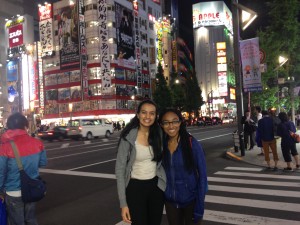
My first week in Japan truly flew by, and I am starting to realize that three months will go by faster than I initially expected. Every day I am learning more about the Japanese language, culture, and people, and I find that I am not so afraid anymore of making mistakes and facing difficulties involving language barriers. Prior to arriving in Tokyo, we talked about Japanese modesty (kenkyo) which immediately became apparent when we met the people involved in organizing the Nakatani program and guest lecturers. For example, when we ate lunch with Nakatani Foundation Chairman Karube-sama at the Sanuki Club, he was more interested in learning about our interests in research and Japanese culture than in talking about himself. This modesty ties along with gift-giving (omiyage), which I find to be a very unique cultural aspect in Japan. I find that gift-giving fully highlights Japan’s appreciation for the people around them and respect for people’s actions and generosity. Omiyage brings society together and ensures that the people who help make a difference are noticed and respected. When I travel to different places in Tokyo, such as Shinjuku and Akihabara, I am more conscious of buying small gifts that I can give to my lab mates once I start researching at Chiba University and my friends back at home.
I am surprised by the amount of Japanese I have been able to learn during our first week of language classes. The Japanese classes have been effective, fun, and thought-provoking, and I like that we have a different sensei teaching us every day. I was unable to learn Hiragana and Katakana prior to the start of language classes, but I am making my best effort to keep up with the class and learn as much as I can. I find learning Japanese challenging and frustrating at times, especially when I cannot remember words that I have repeatedly come up in class in the past, but all our teachers are really patient and encouraging.
By far, my favorite activity during my first week here was going to the sumo wrestling tournament. The whole experience was exhilarating, and it was nice to sit back and relax with the other Nakatani students along with Professor Kono, Packard-san, Endo-san, and Ogawa-san. Sumo was not what I expected it to be; there was a distinct cultural ritual that preceded each match. Sumo is more than just a sport; it is a way to preserve traditional values. I noticed that many ancient traditions have been preserved in sumo, such as the use of salt purification, which originates from when sumo was used in the Shinto religion. My travels to the sumo wrestling tournament via subway was also an observational learning experience for me. Living close to New York City, I thought I would be used to public transportation and the busy stations. However, I was taken by surprise the relatively quiet cars throughout the train and people’s propensity to stow away bulky bags on the above racks to avoid touching others. Although the subway cars were packed, people refrained from talking on their phones and pushing anyone to the side in order to exit.
Despite my lack of prior knowledge of material science and quantum mechanics, I found Professor Kono’s lecture both informative and insightful. His lecture was a great way to kick off the Introduction to Science and Engineering seminars we will be listening in on during our three week stay in Tokyo. Since I will be taking part in a nanoscience project over the summer at Chiba University, I am sure that many of the topics Professor Kono brought up will be related to my research as well.
Question of the Week
One question I have about the Japanese culture involves their food. What does the typical Japanese diet consist of, and has it involved over the years? As a vegetarian, I have found it a little difficult to figure out what I can and cannot eat, but having someone help me read the ingredient labels on packages in the local konbinis have significantly helped me. Although many main dishes contain fish, I have been enjoying different types of onigiri and have even managed to identify several vegetarian sushi options. I wonder if the foods we have been eating at the Sanuki Club and bento boxes people have been purchasing from street vendors are typical foods that you would typically find in a Japanese diet.
- Nakatani RIES Fellowship Tip: Be sure to check out the Food in Japan page of our website for helpful resources on Japanese food/cuisine and resources for vegetarians in Japan too!
Introduction to Science & Engineering Seminar Overview
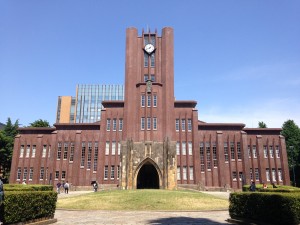
I found our first Intro to Science and Engineering Lecture and Lab Tour at the University of Tokyo both interesting and insightful. Since my project will be related to nanoscience, learning about material science and quantum mechanics is fairly related to what I will be working on this summer. The main idea I got out of the lecture is that there are several factors that affect conductivity: temperature, band gap, electron density, and mobility. I learned the difference between electron mobility and hole mobility, which involves n-type and p-type semiconductors. An interesting property that metals have is their high conductivity, which means that they either have a high density or high mobility of electrons. We can find out which one is the cause by using the Hall Effect, where the hall electric field is proportional to the current density and magnetic field current perpendicular to the magnetic field. Although we can learn from high conductivity metals, we can gain more knowledge from insulators and semiconductors, which have low conductivity. I learned that for insulators and conductors, temperature is inversely proportional to resistance.
The lab tours around the University of Tokyo opened my eyes to the expansion of science and technology. Touring a mechatronics lab, a medical applications lab, and even the department of naval engineering was a great way to gain a wider understanding of the diversity of engineering studies. I was most fascinated by the Mitsuishi Sugita Lab because of my interest in biomedical engineering. The ultrasound device used for studying the kidney, as well as the robotic surgical arm were types of projects that I hope to be working on in the future as well. I would like to receive additional information on how these devices are controlled by humans and future directions these projects will take.
Initial Research Project Overview
Recently, Aoki-sensei’s lab at Chiba University has been focusing on two-dimensional materials such as graphene and molybdenum disulfide (MoS2). According to Aoki-sensei, both materials are very interesting and I can learn the semiconductor fabrication process using them, an area of study I have no prior knowledge about. I will be joining a research project on the transport properties and analysis of two-dimensional materials such transition metal dichalcogenides. Specifically, the research team is interested in MoS2 and have recently found some interesting properties involving field-effect transistors. Field-effect transistors are transistors that use electric fields to control the shape and, thus, the electrical conductivity of a channel of one type of charge carrier in a semiconductor material. These transistors are preferred for weak-signal work (such as for wireless communication) and for certain circuits and systems.
In one of Aoki-sensei’s most recent papers, “Charge Trapping in Monolayer and Multilayer Epitaxial Graphene“, the research team studied graphene devices over a wide range of temperatures. The number of charge carriers per volume of both multilayer and monolayer epitaxial graphene (growing a crystal of a particular orientation on top of another crystal) was found. Aoki-sensei and his team discovered that under high temperatures, usually above 200 K, the carrier density shows an inversely proportional relationship with temperature. These results produce activation energies for charge trapping in graphene. The epitaxial growth of graphene was controlled by annealing in a varying set of temperatures and dwell stages in argon gas. This part of the experiment was set at a certain pressure using a commercial furnace. The temperatures were measured and controlled using a thermocouple, which is a sensor. Afterwards, this was studied through tapping-mode atomic force microscopy and the transmission electron microscopy. According to the results, if mobility increases, activation energy decreases. The vacuum annealing experiments conducted suggest that the SiC-graphene interface plays a role in charge trapping in epitaxial graphene devices. Charge trapping involves fewer process steps and higher yields. Furthermore, the results demonstrate that the binding energy for charge trapping decreases with sample quality. Charge trapping, which could be detrimental to device operation over different temperatures, can be reduced by improving the sample mobility. By using low temperatures, the team was able to obtain a fairly constant carrier density of monolayer graphene. This serves as an advantage for making electronic devices that can operate over a wide range of temperatures, as tested.
Additional readings Aoki-sensei told me to learn about: “Electronics and optoelectronics of two-dimensional transition metal dichalcogenides”
Week 02: Trip to Akita
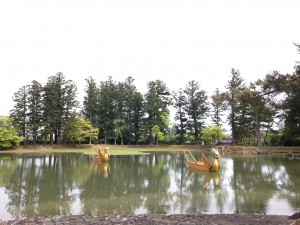
Traveling to Akita was one of my favorite weekends thus far in Japan. Not only did I get to visit a more scenic, rural side of Japan, but I also was able to learn a lot about the area from the Japanese students who we traveled with. Interacting with students from Keio University, the University of Tokyo, and Akita University gave me the opportunity to learn about Japanese culture and make lasting friendships. It makes me happy that I am already close with several of the students, and we have already made plans to meet up one weekend so that they can show me around. Since I will be alone at Chiba, I feel comforted knowing that I have someone to speak with if I am having any difficulties with the language barrier.
Sitting next to the window on the Shinkansen, it was interesting to see the buildings becoming more spaced apart and the number of rice fields increasing as we approached Akita. Simply put, Akita was picturesque: the mountains in the distance and the greenery were a nice change from the business of Azabujuban. On our first day in the ryokan, I enjoyed pounding mochi and eating a traditional dinner with everyone. At night, I was hesitant to try the onsen, but Haruka, one of my roommates from Keio University, encouraged me to come. It was comforting to have her explain to me what to do, and once I entered the pool-sized tub, I immediately understood why onsens are so popular in Japan. Afterwards I felt much more relaxed and I enjoyed the talks and games we played with the Japanese students at night.
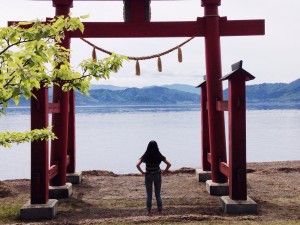
At Lake Tazawa, a few other students and I rented bikes and rode along the shore. The view was so amazing that I actually fell off my bike once because I was paying more attention to the overlooking mountains than on the path! I learned that Lake Tazawa is the deepest lake in Japan, so at least I didn’t fall into the water…I also learned that it is really important to plan ahead and figure out where exactly I want to go if I will be traveling during the weekends this summer. Many signs are only in Japanese and some of the rural places can be confusing to navigate, so I plan on looking up directions on my phone using the “Tokyo subway” app and local area maps. I am having a difficult time navigating to places by foot and by subway by myself, so I would like to make it a goal to become more comfortable with reading maps and planning ahead. I am also looking forward to meeting up with the new friends I made in Japan because traveling as a group is always more fun! The Kamakura trip we took on Saturday with some of the KIP students consisted of hiking, visiting shrines, taking pictures at Enoshima Island, and seeing Big Buddha at Daibutsu. We definitely would not have been able to see this much without the KIP students leading the way.
Language classes this week were heavily focused on building up vocabulary. Although I struggle to remember all the terms we are learning, I find that I now know enough adjectives and nouns to connect sentences together and am able to describe the places around me. Going to the AJALT office on Thursday was also a great opportunity to practice using Japanese in order to hold a conversation. It was difficult to understand what questions the teachers were asking me because their dialogues were faster than what I was used to in class, but once I heard the question a few times I was able to understand what was being asked. I am learning to build sentences with the words in my mental “word bank,” which I think is great progress with only two weeks of Japanese classes.
After visiting Ueno Park to check out the National Museum of Nature and Science, I am starting to wonder if this museum hot spot attracts more Japanese students or foreign tourists. Most of the descriptions of the displays were in Japanese, so it was difficult to understand the significance of each piece. We saw several school groups in uniform walking around the museum and around Ueno Park and it made me wonder if the museums were mainly occupied by students for school field trips or if tourists come to simply appreciate the displays and art work. In general, do foreigners have a difficult time coming to Japan compared to other countries, or is the language barrier at the same level in most countries?
- Think about parks, museums and other sights in the U.S. though too. During the middle of a work day, aren’t there typically more school groups visiting overall? Even people who live in cities with plenty of museums often visit only occasionally or when family come to visit and you need to ‘show them around town’. Also, museums in the U.S. typically only have placards in English too, even in places where there are many foreign tourists so its not too surprising that museums in Japan only have placards and signs in Japanese. One museum on Odaiba that you might want to also visit though is Miraikan: The National Museum of Emerging Science and Innovation as they have tons of interactive exhibits so even if you can’t read the placards you can still interact with and learn about the science behind the exhibits.
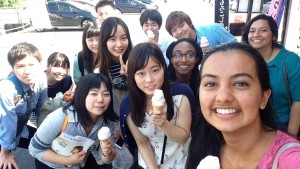
This week’s evening discussion was thought-provoking and fun to discuss with the Japanese students. The topic was on what artificial intelligence systems can do versus what humans can do. Several ethical issues of engineering were brought up, along with philosophical ideas such as the action versus structure model which I analyzed in my Ethics to Engineering class I took last semester. Our group discussed how people are not inclined to seek medical attention from possible robots that will be able to perform certain surgical procedures in the future because they want personal care and comfort. However, artificial intelligence systems such as driverless cars are the future we are heading towards and can debatably provide a safer means of transportation. It was interesting to hear people’s varying opinions about the advantages and limitations of artificial intelligence.
Introduction to Science & Engineering Seminar
This week’s Intro to Science and Engineering Seminar further enhanced the topics that Professor Kono brought up about the different uses of semiconductors and terahertz dimensionality. Through Professor Stanton’s lecture on semiconductor nanomaterials, I learned that semiconductors have a gap in the energy versus momentum electronic band diagram, and that a band gap is needed to make a good transistor. Also, in order to make optical devices, a semiconductor is needed because gaps are required to make lasers and LED’s. Otsuji-sensei’s lecture clarified for me some of the main ideas of the relationship between graphene and terahertz. I now have a basic understanding of how the terahertz gap separates electronics and photonics. Since my research involves semiconductors, I found both Professor Stanton’s and Otsuji-sensei’s lectures to explain some of the concepts covered in the review paper that Aoki-sensei has asked me to look over before my arrival in lab.
Furthermore, I learned that a black body spectrum is temperature-dependent and that black-body radiation has a continuous frequency spectrum. Black-body radiation provides insight into the thermodynamic equilibrium state of cavity radiation. The study of the laws of black bodies helped to establish the foundations of quantum mechanics. Supported by Planck’s law, we find that temperature increases with higher frequencies. At high enough temperatures, black bodies emit visible light, and some of this energy is radiated in the ultraviolet spectrum. During the first seminar this week, I learned that the Sun is 5800 K at its surface, and that the average power of solar radiation on the upper atmosphere of the earth is approximately 1390 W/m2. The energy that a black body radiates is spread over all wavelengths. Maximum energy is radiated by these black bodies at a wavelength proportional to the inverse of the temperature. Based on further research on this topic, I learned that radiation coming from the Sun is not equally distributed over Earth due to its spherical shape. Since the Sun lights only half of the planet, and since maximum radiation comes in around noon time, there is an unequal distribution at any given time.
Most solar panels are only around 11-15% efficient, hence you would need a very large solar panel to power a laptop. I learned in my physics class I took last semester that according to the second law of thermodynamics, you cannot create a 100%-efficient solar cell. The Carnot cycle can be applied to solar energy systems, where the hot side is the temperature of the Sun and the cold side is the temperature on Earth. Energy is lost through heat, hence solar power efficiency is relatively low. The average laptop needs about 85 watts of power, hence with solar efficiency of about 15%, a very large panel is needed.
The research I will be conducting at Chiba University is related to optics. Transition metal dichalcogenides such as MoS2 have band structures that influence the metals’ properties. MoS2 is a diamagnetic, indirect bandgap semiconductor, meaning that the maximum energy of the valence band is different from the momentum of the minimum energy in the conduction band. The optical absorption spectrum of MoS2 shows two main peaks corresponding to exciton bands: the direct-gap transitions at the K-point between the valence bands and the conduction band. MoS2 has sizable bandgaps, allowing applications such as transistors and photodetector devices. Photodetectors are devices that can detect light by using the electrical effect of individual photons. Its optical properties allow for future advances in electronics and optoelectronics. Overall, the subsequent lectures have been enhancing my understanding of the properties and uses of semiconductors.
Week 03: Noticing Similarities, Noticing Differences
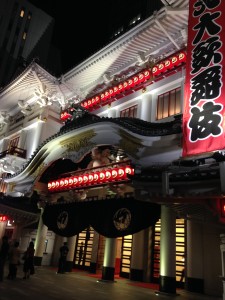
Week three has been filled with more sightseeing and opportunities to practice my Japanese. With all the traveling we have been doing, I have noticed more of the subtle differences between public transportation in Tokyo and the United States. I think the most distinctive aspect is the mere punctuality of all of the trains—and the people—in general. All of our scheduled events have started exactly on time, and I have never encountered a delayed train thus far. This difference still catches me off guard because I am used to events starting late, and it is pretty typical for the New Jersey transit train that I take to go to New York City to be a few minutes behind schedule. Initially I viewed people to be a bit too uptight about our scheduled events and the emphasis placed on arriving a few minutes early, but I now view this punctuality as being both efficient and effective. The punctuality of the public transportation system follows the core Japanese values of respect because being late is regarded as inconveniencing others. I am now more careful about arriving on time because I want people to know that I appreciate that they are taking the time out of their day to be with me.
In regards to the train and subway rides, I have noticed that no one eats or drinks. I like that there is emphasis on eating in designated spots only, such as in restaurants, at home, or in the park, because I believe it creates a sense of grounding and awareness of yourself. By taking the time to sit down and eat, you can focus on the food alone. During school, I would often eat lunch while walking to class or on the bus around campus in order to multi-task. However, I have been enjoying sitting in the park near our hotel to eat after language classes. I feel relaxed and peaceful—yet another core Japanese value that we discussed prior to arriving in Japan. By not eating or drinking in the subway, there is inevitably less trash lying around, despite the lack of public garbage cans around Tokyo.
The Japanese also value personal space and privacy. One incident that occurred on the subway was that my backpack must have brushed against one man’s shoulder. When I turned around to apologize, he seemed to look really annoyed and angry. I was pretty surprised because using the New Jersey Transit and the New York subways my whole life, I am used to being pushed around having a lack of personal space. I was a little embarrassed that the man was annoyed that my bag momentarily touched him, but in retrospect, he was just reacting in the way that follows core Japanese values. I appreciate the Japanese’s value of personal space even on public transportation and refraining from talking on the phone (I even read a sign that said talking on the phone was prohibited when the train was crowded). Also, despite the fast-paced life of Tokyo business workers, no matter who I approached for directions, everyone was more than willing to personally guide me in the right direction. One time, when I could not find a particular connecting line, a woman personally went up the stairs with me and walked me to the right train. The selflessness and kindness of the Japanese is something I will always admire and cherish throughout my stay in Japan.

Saying goodbye to the language teachers after our last class was bittersweet. Although I was excited to go to Chiba to start my research internship, spending every morning with the language teachers was surprisingly fun. They are undoubtedly the most patient, kind, and enthusiastic language teachers I have ever had and made learning Japanese a very interactive experience. A few days ago I went to the post office to deliver several post cards, and I was able to ask for postage stamps and respond to questions on my own. Although I still have a lot of Japanese that I need to learn, I am happy with what I was able to accomplish by week three.
Earlier this week, one of the KIP students reached out to me after finding out about my interests in biomedical engineering, I had the opportunity to given a brief presentation on genomic analysis and bioethics during this week’s evening discussion. Last semester, I took a course called “Ethics to Engineering,” so bioethics is a topic I am interested in learning more about. I brought up CRISPR-Cas9 gene editing, the Human Genome Project, and a current ethical debate that has arisen over studying lab-grown human embryos (http://www.sciencemag.org/news/2016/05/why-lab-grown-human-embryo-has-reignited-old-ethical-debate).
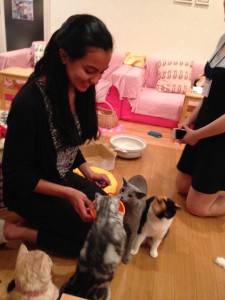
Our last day in Tokyo as a group was even more fun because some of the KIP students joined us on our outings. We went to Tsukiji market in the morning for fresh sushi, stopped by the Imperial Palace gardens, and even went to a baseball game in the late afternoon (I was rooting for the Tokyo Fowlers!). Several of us wanted to spend more time with one of the KIP students who was free in the evening, so she took us to Shibuya after the baseball game and I finally got to experience a cat café! We also went to a purikura photo booth and exchanged a lot of laughs. Earlier in the week, I also got to go to Sunshine City Mall and check out the Pokémon store, and on Friday we went to a kabuki show in Ginza. Overall, I feel like I have had a very culturally-immersed week, where I got to experience many of the entertainment sites and attractions people go to with friends and family. Our last week in Tokyo together was definitely my favorite week thus far.
Introduction to Science & Engineering Seminar
This week during lectures, I got to meet my research professor and US co-advisor, Prof. Aoki from Chiba University and have lectures by Prof. Jonathan Bird from the University at Buffalo. The topics they discussed were exactly related to the type of work I will be conducting during my internship, so many of the points they brought up clarified some topics I was having trouble understanding. Primarily, I learned that Moore’s law is an empirical observation that allows people to understand the direction that the semiconductor industry is moving towards. The process power of chips has exponentially grown; there are currently about 1.4 billion transistors on a chip to date. However, the problem now is that the semiconductor industry keeps trying to reduce transistor size, but we have reached a point where the transistor will not function as well if it goes any smaller. Now, people are interested in the possibility of moving away from silicon and looking instead towards materials with different properties, such as graphene. Graphene is a special form of carbon that has brittle properties because two-dimensional sheets are stacked one on top of the other and are stuck together due to Van der Waals forces. Graphene has high room-temperature mobility, and its covalent bonding within its sheets causes this semiconductor to be particularly strong.
After more research on nanostructures, I found that top-down and bottom-up methods are two common approaches used for nanofabrication. Generally, bottom-up processing is better because it usually produces nanostructures with less defects. Bottom-up synthesis stacks atoms one on top of the other, creating crystal planes. On the other hand, top-down synthesis removes crystal planes in order to form the nanostructures.
One of graphene’s distinct characteristics is that it does not have a gap between its valence and conduction band. Yet, graphene is a useful material because it is ambipolar: it can be used to conduct electricity through holes or electrons. By looking at bilayer graphene, we can see parabolic energy bands and potentially open a forbidden gap. However, the gap tends to be too small to be a viable option. A more attractive and practical approach is to look at nanoribbons, which I learned were structures created from etching away graphene, leaving a very narrow tunnel. Graphene can be used to make high quality radio frequency transistors. A good example is a cell phone because it does not really matter that a user cannot turn the transistor off for a long period of time since the device is constantly being used. Professor Bird also mentioned near the end of his lecture that MoS2 is a good two-dimensional material to study because with a band gap of 1.8 eV, it has a large enough on/off transistor ratio. I am still trying to figure out what makes MoS2 so different from graphene and silicon semiconductors. Does MoS2 have an exceptionally large band gap? How do silicon and MoS2 compare in terms of transistor properties and capabilities?
Aoki-sensei’s lecture was also informing and different from previous topics we have covered throughout these science seminars. We were given an introduction of scanning probe microscopes and analysis of transport in nanostructures using scanning gate microscopy. Laser detection is used because lasers are highly dense and thus provide excellent spatial resolutions. In laser detection, the probe tip senses surface properties and causes cantilevers to deflect. The cantilever is a spring that consists of silicon nitride that deflects as the probe tip scans sample surfaces. I also learned about two different operation modes: contact (DC) and tapping (AC). In contact modes, soft cantilevers are used. They are generally easy to operate and friction force imaging is available. In tapping modes, hard cantilevers are used and there is very minimal damage inflicted into the sample. This mode applies forces vibrations, but is relatively difficult to set up. On the other hand, for scanning gate microscopy detects change from the current, not from the tip. I now know that as back-gate voltage increases, current decreases. Some segments are visualized along a single-walled nanotube. There is a possibility of using scanning gate microscopy on semiconductors such as a MoS2 crystal. Aoki-sensei mentioned that there is an unintentional potential barrier introduction within a MoS2 channel. After learning more about MoS2, I am interested in finding out what exactly I will be working on with this semiconductor once my research internship begins.
Week 04: First Week at Research Lab
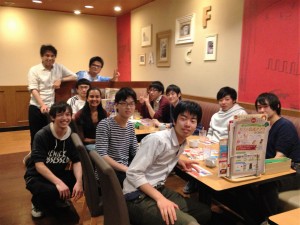
My first week in the Aoki Lab at Chiba University was better than I had imagined—I did not expect everyone to be as friendly and supportive as they are. When I arrived at the station, I was surprised to see that my mentor, Yamanaka-san, brought along two other masters students to greet me and show me to my dorm. Afterwards they showed me the nearby supermarkets and department stores, where they helped me buy miscellaneous items that I needed for my room. My room is bigger than I expected it to be and has a lot of storage compartments, so my belongings do not take up much space. There is a desk, toilet, shower, and a kitchen area with a mini refrigerator, which is really convenient for me because I have been enjoying buying discounted fruits and vegetables from local stands. I am also enjoying the air conditioning and free laundry service—living outside of Tokyo can have its perks. Although it can be really quiet in the dorm building, I am sure I will slowly get used to living on my own.
Overall, I think the students in my lab were really surprised to find that I always tried to speak in Japanese with them and understood the general idea of what they were talking about with each other. They seem to appreciate my constant effort to respond to them in Japanese and are more than willing to answer my questions about the language. Our lab mainly speaks in Japanese, and this has motivated me to attend the language class that Aoki-sensei said I could join once I get my student ID card.
Throughout the week I met more students from the lab, and I have found that most of them understand what I am saying when I resort to English, and some of them can speak English on varying degrees as well. I have noticed that the more I attempt to ask my questions in Japanese, the more they try responding in English. There is one postdoctoral student in the lab from Taiwan that speaks English fluently, and he happens to live in the same dormitory complex as me. On my second day in the lab he approached me and formally introduced himself, and after a friendly conversation he gave me his business card so that I could reach out to him if I ever need help. This simple, kind gesture comforted me a lot, and it is nice to know that I am not the only one trying to learn Japanese.
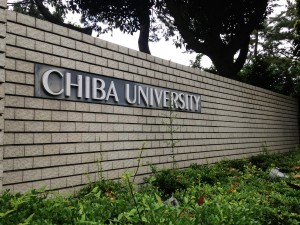
Overall, I was a little nervous coming to Chiba because I did not expect our lab to be as laid back and supportive as it is. Although there is definitely a hierarchy that is determined by year (either fourth year, first-year masters, or second-year masters), everyone is great friends in the lab and Aoki-sensei is easily approachable. Aoki-sensei’s door is always open and he frequently stops by the other student’s work spaces to talk. People definitely respect him and follow his directions, but back in my research lab at my university, we also treat the head research professor the same way so I do not find this to be abnormal.
Everyone is really great friends in the lab and always talk to each other, which can sometimes be frustrating for me because I just do not know enough Japanese to keep up with the conversation. At times I feel left out, but I know that they are not doing this intentionally; our lack of confidence with each other’s languages can sometimes be a difficult challenge to overcome. At times their effort to include me is made clear. For instance, for the welcome lunch that the lab was organizing for me on Wednesday, there was a list of everyone’s name on the board who could attend. I had previously mentioned to Yamanaka-san in passing that I was learning hiragana and katakana but could not read kanji, and he went ahead and rewrote everyone’s name in katakana to help me shortly afterwards. Also, two students walked with me to the station one day to help me buy a discounted, student train pass from the station near my dorm to the station right outside of Chiba University. Although they were busy with their own work, they voluntarily helped me, which was a relief because I would have struggled communicating with the attendant on my own. Overall, the lab is a really great team to be a part of, and I hope that we find a way to better communicate with each other. I think communication will definitely get easier once I make even more progress in my Japanese communication and once they realize that their English-speaking is better than they give themselves credit for. To help me remember people’s names in the lab, some of them have given each other English nicknames, which makes everyone laugh and jokingly tease one other!
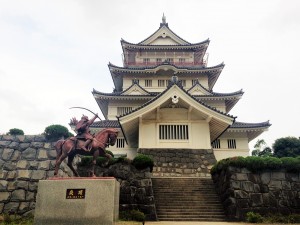
Question of the Week
A question I have is about Japanese schooling. Are students required to take English in high school or college? If so, are these classes generally taught by native speakers? Or, if not, what methods do students use to self-study the language?
- For more information see the ‘Education in Japan’ section of our Life in Japan resources page.
Overview of the Three-Week Orientation Program in Tokyo
Overall, the orientation program was structured so that we were able to learn a lot about Japan’s language, culture, and values before departing our separate ways for our research internships. Taking Japanese classes in the morning, listening in on STEM-related lectures, getting to know the KIP students, and sightseeing with the other Nakatani fellows eased my transition into Japan and made me even more excited to learn. The amount of Japanese we learned in three weeks is pretty impressive, and it has sparked my interest in learning more so that I can communicate with others even better. Fortunately, I was able to enroll in two different Japanese classes at Chiba University: a second-level language class that meets three times a week and a conversational class that meets once a week. Since our lab work generally does not start until 10am, taking these classes earlier in the morning makes me feel even more productive and is a great way to stimulate my conversational abilities. My personal goal is to learn new words every day I am here—learning a new language is definitely a collective process.
I figured out early on that the Japanese are genuinely caring, selfless, and kind. Being greeted as I walk into a grocery store, seeing everyone bow to each other as an acknowledgement of each individual’s presence, and personally being escorted in the right direction when I am lost are only a few of the events I have observed during my time here. I believe that being surrounded by such graciousness has made me more aware of my actions and attitude. Japanese culture has made me appreciate the things people do for me so much more, and I strive to show people the same amount of care and effort. One thing I have become aware about myself is that I like asking questions. Whether I do not understand something that is going on in the cleanroom or am not sure what train to get on, I ask my questions to others, who graciously answer them. Asking for help during various challenges I have experienced thus far have also helped me improve my ability to communicate with others because I am constantly learning new ways to ask my questions in Japanese. All in all, I am pleased with the progressive amount of Japanese I am learning and with the amount of sightseeing I get to do, which are helping me learn about the country’s unique culture.
Research Project Overview
On the first day, my lab group and I had a meeting with Aoki-sensei to talk about our research, and he proposed four interrelated projects that we will be conducting. In the beginning I will most likely be watching my lab group perform their experiments and asking questions, but near the end I might be able to start working on one of the projects independently. However, Aoki-sensei said that if I do not get to do this it is not a big deal—either way, I will be learning new techniques and gain a wider perspective about nanoscience research. Since I only completed my first year in college and my prospective major is Biomedical Engineering, I have never worked with semiconductors and transistors. Hence, any exposure I get to research on nanostructures will be worthwhile and a learning experience for me.
Aoki-sensei first started off by giving some background information about MoS2 and the paper some students in the lab recently submitted. MoS2 looks similar to graphene from a top view, but from the side it looks different because unlike graphene, this semiconductor consists of two elements. I was also initially confused about what 1T meant in the paper he had emailed to me a few weeks back, but now I know that this refers to tetragonal symmetry, where there is one layer per repeat unit. If a material is classified as 1T, then it will most likely show metallic characteristics. The main part of the meeting consisted of Aoki-sensei explaining to me a specific phenomenon the lab found on a current versus voltage graph. By looking at current versus voltage at Vg=0, Aoki-sensei’s lab found a very large current jump at 400 K. At -40 V, the increase in current is not drastic, and at +40 V the current begins to drop back down. The sudden increase at V=0 is because there are no captured electrons in the SiO2 layer. The effect is ultimately due to the charging of MoS2. However, what the lab has not found yet is what occurs at different temperatures at different voltages. The lab wants to find out more information about the effect of field cooling around room temperature. By keeping the voltage at 40, we want to reduce the temperature from 500 K to room temperature in order to confirm the memory effect of temperature. After reading additional papers Aoki-sensei printed out for me, it is clear that the sudden increase in current that appears on the graphs is caused specifically by SiO2. Another topic discussed was top gate and back gate voltage. I will be learning how to make a top gate structure consisting of boron nitride and MoS2. This will be attached to a back gate consisting of silicon, chromium, and gold. As discussed, the current jump will be caused by the charging of SiO2.
Our project is segmented into four components: 1) studying the effects of temperature on the voltage versus current graph, starting from around 500 K to room temperature, 2) creating a top gate structure with monolayer MoS2, 3) studying the characteristics of a three-layer MoS2 structure, and 4) using scanning-gate microscopy to study the n-type characteristics of chromium and gold. Before we begin researching these topics, we must first create our sample consisting of SiO2, Au, and MoS2.
Unfortunately, the sample we fabricated throughout the week, consisting of SiO2 and MoS2, failed, so we will now work on making a new one. In our original sample, our graph showed noise and was not the positive, linear line we were looking for. A current would not be able to pass through our sample because there was a lack of contact between the SiO2 and MoS2 layers. Our lab group tried reheating our sample from room temperature to 500 K, but this did not fix the problem, hence a new sample must be made so that we can use it to conduct our four areas of study. Aoki-sensei proposed that we should try using a thicker layer of SiO2 to ensure contact.
I was happy that I was allowed in the clean room to start our research project on the first day. Although there are times when the students cannot fully describe what they are doing in English, they put in their best effort to do experiments in front of me and show me around. Also, hand gestures and pointing things out go a long way in explaining procedures when it is difficult to describe in words. This week I got to fabricate my own SiO2-MoS2 sample for practice and looked at it under a scanning-probe microscope, where I got to determine whether MoS2 was monolayer, bilayer, or three-layer by comparing it to a gray-scale graph. Through this process, I learned where all of the chemicals and semiconductors are stored in the clean room as well as proper safety procedures using the fume hoods and toxic chemicals, such as H2SO4. Throughout the week, I have learned how to open and close the vacuum-sealed box where SiO2 is stored, cut SiO2, use the various hotplates, and the scanning probe microscope. While cutting 5mm X 5mm SiO2 squares, I learned that the top, shiny side is SiO2 and the bottom, matte side is Si. After discussing more about my research with Professor Bird, I also learned that MoS2 is quite similar to silicon because it has a large bandgap. However, MoS2 has a lower carrier mobility is much lower, which means that it does not support as large currents as that material. Our research on monolayer MoS2 may allow us to study scaled transistors at smaller sizes than is possible for silicon transistors.
Week 05: Critical Incident Analysis – Life in Japan

This past weekend was filled with cross-cultural experiences in regards to communication. Through traveling, not only did I get to meet up with different groups of friends, but I also met new people that made my trip even more memorable. On Friday, my friend from Cornell and I planned on meeting at Shinjuku station in the evening to go to Chigasaki. I did not realize how big and confusing Shinjuku can be for a foreigner, so it ended up taking an hour to find each other in the crowded and maze-like station. I found it frustrating because I can usually read the signs to guide me in the right direction or ask someone for directions, but I was stuck in the evening rush hour for when people were going home from work so it was difficult to find someone who could show me where specific exits were. Once my friend and I were able to meet up, we spent even more time circling the station to find the right train and ended up in one of the most packed train cars I have ever been on. I was told that the subways and trains in Japan were always really congested during work hours, but this was even more extreme because one of the previous trains had gotten delayed. Out of luck, we happened to be next to a man that started a conversation with us and knew fluent English because he had lived in the US for 16 years. He asked us where we were headed to and told us that we were on the train that was delayed, not the one that was supposed to come after it. He proceeded to tell us where we should transfer, and it was at this moment that I was genuinely thankful for having someone explaining directions in the language I am most comfortable with. The language barrier is definitely not something that can be easily overcome; not being able to fully communicate can generate misunderstandings, confusion, and even sometimes frustration. We were thankful that this kind man had helped us, otherwise we would have ended up in Kamakura.
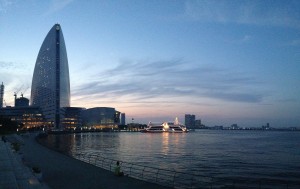
When my friend and I reached Chigasaki station, we also had difficulty finding the place we were going to be staying at for the night. We ended up walking to a Seven Eleven to ask for directions and the owner pulled out a map to explain to us where we should head towards. Since we had asked for help in Japanese, the man must have assumed we understood everything he was saying because he explained where to go very quickly and without hand gestures, so it was difficult to understand. The map was also confusing to read so we ended up thanking him and leaving the convenience store more confused than ever before. Fortunately, someone outside was kind enough to walk us to where we were supposed to be headed towards and we finally found the place we were going to be staying at. After hours of feeling lost and not being able to communicate with people effectively, it felt good to make it to our destination and laugh about what had just happened for the past few hours. Despite our late arrival, our host for the night loved talking to us, and he later told us that we were his first American visitors. Our conversation was a mixture of both Japanese and English and even though there was some confusion as to what one another was trying to say sometimes, we ended up learning a lot about each other. If I have the opportunity to, I would definitely like to meet up with our new friend again and talk some more. I really appreciated his motivation for attending to guests in his own home: he wants to meet people with varying backgrounds to learn and gain a wider perspective about the world.
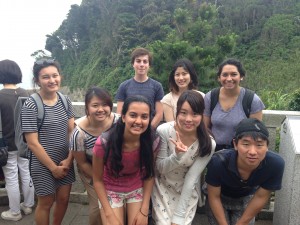
What I learned from this weekend is that language difficulties and miscommunications are bound to happen when traveling to another country, but these challenges should be embraced; not dreaded. I ended up meeting people that made my experience even more meaningful and memorable. Despite the frustrations of not understanding what people are saying at times, with patience and an open-minded attitude, I am able to learn about people’s motivations and truly experience the kindness of the Japanese people wherever I go. There is really something special about the generosity and selflessness that I have felt from both the man we spoke to briefly on the train and the owner of the apartment we were staying at in Chigasaki. The struggles of navigating a new country have positively shaped my summer and perspective about international relations.
Question of the Week
My friend and I used Airbnb.com to find a place to stay in Chigasaki, but I wonder what the most common means of finding a place to stay overnight is in Japan. I know that hostels are commonly used throughout Europe—how about in Japan? Also, are ryokans more popular than standard hotels?
- We’ve shared a lot of information on accommodations in Japan on the Travel in Japan resources page of our website and on pgs. 71 – 76 of the 2016 Nakatani RIES Schedule/Guidebook. Airbnb is new to Japan, and something that not many of our students have tried before as it just began to be common in Japan in the past 1 1/2 to 2 years. In terms of what locals use, business hotels are quite common and popular for an inexpensive stay in cities that you may be traveling to for work or pleasure. For example, the APA hotels are a national chain that has locations in most major cities. There are also hostels throughout Japan and a number of different websites that you can look for this type of lodging on.
Research Project Update
This week my lab group has continued to work on making a successful sample to be used for our four different experiments, which has turned out to be both tedious and difficult to get right. Through this process, I have learned how photolithography works using an optical microscope. I now understand why we put a drop of red V90 solution on our sample after locating monolayer MoS2. V90 serves as a photo resistor, which we need to study under the optical microscope. Being able to read katakana also became useful because I was able to read “photomasks” on the container, which we also placed under the microscope along with our sample. A photomask is a photographic pattern used in making microcircuits, where ultraviolet light are shone through the mask on to a photoresist (our sample covered in V90) in order to transfer the pattern. We placed the monolayer MoS2 part of our sample between the gap present on the photomask and shot UV rays at this spot. Once we manage to create a suitable sample, I will learn how to use one of the other microscopes in the clean room to measure p-k voltage.
My group has been having difficulty finding MoS2 on our sample fabrications because they are so rare to come by. Countless days have been spent searching under the microscope for this monolayer, but this has given me the ability to get comfortable with making new SiO2-MoS2 samples without having to refer to notes anymore, using the scanning probe microscope, and studying the gray value of MoS2 graph (comparing shading difference versus the SiO2 background) to see if we found a monolayer. We have gotten really close to making a functioning sample. Earlier this week, we found monolayer MoS2 and proceeded to attaching polypropylene carbonate (PPC) on a glass slide to h-BN on our SiO2-MoS2. Once we were able to do that, we brought our sample to the spin coater and put one drop of V90 solution. After heating it on the hot plate, we used the optical microscope to apply UV rays through the process of photolithography. Our first attempt at this repeated process was a success, but unfortunately, the third time around, we saw a visible ring around where MoS2 was supposed to be, caused by the UV rays. We have not gotten this close to making a full-functioning sample since then, but I am sure that we will get it right after a few more tries.
I am also really glad I wrote down in my notebook all the steps in making a sample. I did not expect to be allowed to fabricate samples on my own so early on, but I got in the habit of writing down everything my lab group was doing since my first day in lab and it ended up coming in handy. Initially, my mentor followed me around to help me open the vacuum seal on the box that we store SiO2 in, to tell me how long to heat the sample on the hotplate, etc. However, he realized that I had scribbled detailed notes about the whole process and even where we stored different chemicals, so he ended up telling me to call him over if I needed help and proceeded to complete his own work. It made me feel good to be able to do something independently, but it also feels good to know that I will always receive help if I need it. I am glad that I have been taking detailed notes because I look through them whenever I get the chance to ask Aoki-sensei or the English-speaking PhD student from Taiwan about the things I was not able to understand at the time.
Week 06: Preparation for Mid-Program Meeting
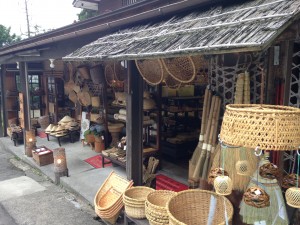
Outside of lab, my biggest personal accomplishment has been living on my own. I was initially nervous to be by myself in Chiba. Even in college, I had two roommates, so I was not sure if I would enjoy living by myself. However, I think this experience has helped me become a more independent and confident person. Even on weekends, when I travel to different places to meet up with friends, I feel comfortable figuring out directions on my own, something I struggled with the beginning of the summer. In Tokyo, when all of the Nakatani students were together, it was easy to rely on others to figure out how to get to our destinations, but living on my own has given me the opportunity to plan my own trips and look up schedules by myself. Through this experience, I have also realized how much I enjoy planning weekend trips and looking up new places to go to. Asking my lab mates about places they recommend going to and searching online has given me the chance to shape my own summer and see the things I am most interested in.
My biggest personal challenge has been coming out of my comfort zone in order to communicate with others in a language I am still learning. Especially in lab, it would be easy for me to do my work quietly and listen to everyone else converse. However, I push myself every day to not care about saying something wrong or thinking that I might embarrass myself. My lab mates have definitely helped me build my confidence in myself in speaking in Japanese because whenever I try to speak in their language, they try speaking in English. Neither of us speak each other’s languages fluently and there is sometimes some laughter when we do not quite understand what the other person is trying to say, but it is a struggle that I appreciate facing. It can be frustrating at times to not be included in some conversations that my lab has during free time, and sometimes I find myself just minding my own business and keeping to myself, but I have noticed that if I interject and try to speak in Japanese, they make an obvious effort to talk to me as well. At first I thought that some of my lab mates may not want to talk to me, but it is apparent now that some of them must feel intimidated for not knowing much English. However, whenever there is someone around who would be able to translate some of their Japanese for me, they are happy to be around me. I also continue to make an effort to speak with everyone in my lab and not just the people I find it easier to communicate with. Through this challenge, I have gotten to know some of my lab mates on a more personal level. I now know whose manga collection is stored on the bookshelves of our desk area, who also likes playing tennis, and places that people would like to travel to in the future. We have also made plans to have a lab outing some time next month, possibly to Odaiba. It has been fun looking up places that we can go and teaching each other new words. Half of my lab notebook is new words that my lab mates have taught me, and words that I often hear when they are talking amongst themselves. I have been enjoying building my Japanese vocabulary to make casual conversations more descriptive.
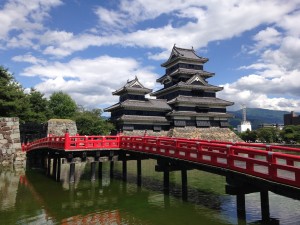
In regards to the process of our research, we have been getting very close to fabricating a sample, but have had some difficulties during the fabrication process. Finding a large enough fragment of monolayer MoS2 has been the greatest challenge, but performing photolithography on this area is also a difficult task. Although we were hoping to have the exfoliation process a while back, I am sure that we will be able to create a sample to be used soon. However, I am not concerned because I have learned so many new skills throughout this process. Even if I do not get to witness any of the actual experiments that will test our hypotheses, I am glad that I was an active member in the fabrication process. Learning about semiconductors and scanning probe microscopy both from Aoki-sensei and in person in the clean room has helped me gain a wider perspective of the types of cutting-edge research that can be applied to modern devices.
Question of the Week:
Are there actual rules about eating in public, or is it just something that people choose not to do in Japan? I always feel a little strange when eating in public areas because no one else ever seems to be, but when I am in a hurry and cannot find a bench (which happens often), I resort to eating in public areas. Do different places have defined regulations about where you can eat and drink, or is it a social custom that people have adopted?
- Yes, you are correct, eating in public in Japan is typically looked down upon but you do see it from time to time. There are some interrelated issues here. First, no matter how careful you are eating in public (or while walking) you are inevitably going to drop some crumbs or spill a little of your drink and someone else will either have to clean this up or may sit down where you were and end up with a mess on their clothes. This is why almost also public floors or sidewalks in the U.S. can be sticky at times because we do eat in public or while walking but you rarely find this in Japan. Second, places where it is okay to eat in public are typically those located close to a public trash cans (which are rare in Japan) so that you can easily throw away your trash and so that others know that is a place they need to be careful of crumbs/spills. Otherwise you have to carry that empty wrapper with you in your bag until you get back home or back to your office to throw it away. Yet another reason is that, compared to the U.S., there are typically more set times for meals in Japan and the time you take to actually sit down and eat a meal at a table is a sign of respect; not only for the cook who prepared your meal but also for the food itself. Lunch time in the U.S. typically means eating a sandwich at your desk while working, but in Japan its a time when everyone takes a step away from the office and goes out to the cafeteria or a restaurant together. Food is a way to bring people together but also an important way to demarcate your day through set breakfast, lunch, and dinner times. Etiquette is more about proper behavior that makes society run smoothly than hard and fast rules and every person has to make their own individual choices about what they choose to follow and what they don’t each and every day in all societies. However, eating and drinking in public almost always makes the list of those etiquette mistakes most commonly made by foreigners in Japan.
Research Project Update
We have faced some challenges throughout the exfoliation process, but we have gotten closer than ever before in making a successful sample. This week, we managed to perform photolithography by using V90 resistor. I learned how to change the current and voltage by using one of the devices in the clean room. We set the voltage to -40V and waited for the voltage gate to drop to zero. Our attempt was unsuccessful, though, but this was the farthest we have ever gotten so it was a step in the right direction. My mentor explained that we might have failed at this stage because our sample’s edges were jagged, which might have interfered with the current. He attempted to smooth out the edges, which seemed to help a little. We will now take extra precautions to cut our 5mm X 5mm SiO2 squares more precisely to avoid this interference.
Through the fabrication method, we have found that a relatively large piece of monolayer MoS2, around seven micrometers, works best in the exfoliation process. Also, the piece has to be alone and not connected to any other MoS2 in order to successfully transfer our fragment to the PPC and BN on the glass slide. In device fabrication, I learned about chemical vapor deposition, where the single-domain monolayer MoS2 crystals that we study can be directly grown on SiO2-Si substrate. For metal contact, we use electron beam lithography. We can also use 5 nanometer metal and 50 nanometer gold contacts.
Our group’s goals have been slightly modified; Aoki-sensei said that if we continue to have a difficult time finding and using monolayer MoS2, we can first attempt to study three-layer. From previous research studies in Aoki-sensei’s lab, we know that a much larger current jump occurs with monolayer MoS2 than with bilayer MoS2 at a large voltage (such as -40V), but we are now interested in finding out what characteristics three-layer MoS2 displays. We hypothesize that three-layer will show similar characteristics to its odd-numbered counterpart, monolayer MoS2. Also, if we do succeed in exfoliating a monolayer sample, we want to study why this big jump occurs, which we know is related to hysteresis. Finally, we want to see what occurs when we put a gold transistor on MoS2, which is a good target for contact characteristics. Gold has a Schottky transistor, while chromium does not. I learned that a Schottky diode is a semiconductor diode with a low forward voltage drop and a very fast switching action. A Schottky transistor is a combination of a transistor and a Schottky diode that prevents the transistor from saturating by diverting the excessive current coming in. To study this topic, we will use scanning gate microscopy. Ideally, we will be using monolayer MoS2, but bilayer will also yield similar results so I might use a multi-layered form of MoS2 in order to learn how this topic can be studied, while using my group’s sample to be used for actual data.
Week 07: Overview of Mid-Program Meeting & Research Host Lab Visit
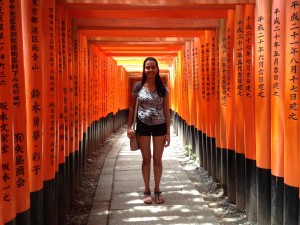
Meeting up with all of the Nakatani students at the Mid-Program Meeting was a great time to reconnect and explore a new part of Japan. I am happy that the meeting this year took place in Kyoto because it gave me the opportunity to visit the Nakatani students at Osaka University a day early as well. I took the Shinkansen to Osaka the day before we all had to meet in Kyoto. After talking for a while and eating lunch together, we went to Expocity and spent hours exploring Expo ’70 Commemorative Park. This was probably the highlight of my trip; we found a tree house with bridges that extended throughout the park. I enjoyed the different views of Osaka that we could see over the trees and exploring the different areas of the park as the sun set.
The Kyoto Mid-Program Meeting was scheduled so that we had the opportunity to share our research thus far, meet new people, go sightseeing, and catch up with the other Nakatani students. I particularly enjoyed the lunch party we had at Kyoto University after completing our research presentations because I got to meet new students. I got to know Japanese Fellow Toshihiro Takada from Ristumeikan University, and I am looking forward to seeing him again at the end of our program in August. We talked about Environmental Systems Engineering and compared culture in Japan and in the United States. I thought that our visit to Kyoto University would be brief and just for presenting our research, but it turned out to be a great way to connect with even more students and learn about new areas in research.
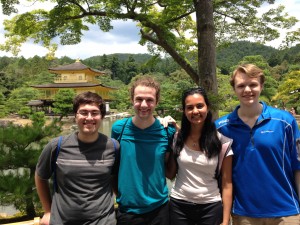
I was most interested in visiting Sysmex Corporation because of their focus on advancing healthcare. I got a better understanding of Nakatani’s purpose for students and why this program is now interested in students from a wider variety of fields, such as biology. The Nakatani Foundation prepared an amazing trip for us to Kobe, where they treated us to a special lunch and a tour of Sysmex. I enjoyed meeting CEO and Chairman Hisashi Ietsugu and learning about the medical equipment they have developed throughout the years. Sysmex has worked on research and development related to immunological diseases, infectious disease, cancer, and chronic diseases According to their website, Sysmex strives to create value-added testing and diagnosis technologies.
There were not any particular challenges on this trip, but traveling such a great distance to get to Osaka enhanced my confidence in traveling by myself. Since I was meeting with some of the Nakatani students at Osaka University, I had to look in advance to see how to get from the Kyoto Shinkansen station to the closest monorail station that the university uses. Navigating around was different from taking the JR lines around Chiba and Tokyo so I initially had a little trouble, but with the maps I looked at in advance and the help I received from a police officer at one of the stations, I was able to make it to my destination. I think that because I have been consistently traveling by myself these past few weeks, I felt comfortable finding my way to Osaka. This is something I definitely could not have said the beginning of this summer, so I am happy with the progress I am making.
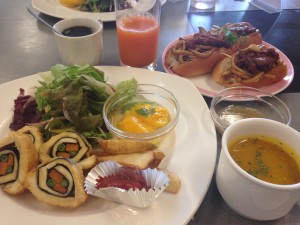
I am happy to be back in Chiba and to be able to share my experience with my lab mates, who enjoyed telling me about the history of some of the places I visited, such as Fushimi Inari Shrine and Ginkaku-ji. I enjoyed describing what I saw in Osaka, Kyoto, and Kobe in basic Japanese, and it was equally as enjoyable to hear what they had to say about each place in a mixture of English and Japanese. Overall, the Mid-Program Meeting was better than I expected. I got to eat the most amazing vegetarian food that the Kansai Seminar House generously prepared for me (grilled konnyaku is one of my new favorites now) and playing cards and Jenga late at night with my Nakatani friends. This trip was a great way to get everyone together again and prepare for our final month in lab.
Question of the Week
When is the most popular time of the year for tourists to visit Kyoto? While we were visiting places such as Fushimi Inari Shrine and Kinkaku-ji, we saw many other tourists as well, but I was wondering if there were any particular events that attract tourists to come at certain times of the year.
- One of the really special things about visiting Kyoto is that each season is special and unique and no temple or shrine will look/feel the same twice because they are so closely integrated with the outdoor landscape and influenced by the changing seasons and weather. Here are some websites that list some of the ‘best’ times to visit Kyoto and the festivals throughout the year.
Research Project Update
While I was away for the Mid-Program Meeting, my lab completed the annealing process for my sample. They studied the electrical conductivity of temperature change from room temperature to 500 K. Each increment of 20 K took twenty minutes. As for the group’s sample, we are still having difficulties with our monolayer MoS2 sample attached to h-BN when we drop the gate voltage to -40 V, so I am continuing to help them make a new sample that we can use.
This week, we performed Raman scattering spectroscopy on my sample, and I learned how this technique can be used to estimate the number of layers my sample contains. After setting up the probes, we were able to graph drain current versus gate voltage. Also, by finding the difference between Raman active modes, A1g and E2g, we were able to estimate that my MoS2 sample has five layers. This was an interesting finding because we had initially thought that the sample was four layers by using the scanning probe microscope. This underestimation may be due to the MoS2 transistor being encapsulated by hexagonal Boron Nitride, which my mentor discussed during our lab’s weekly meeting. The h-BN provides protection from environmental changes, such as temperature. Since we were varying the temperature from room temperature to 500 K, the h-BN might have affected our approximation of the number of layers in our MoS2 sample. It was interesting to connect the new article that my mentor was summarizing for our lab and connecting it to our experiment almost immediately afterwards.
I also revisited why one of the purposes of our study is to compare the characteristics of monolayer MoS2 and trilayer MoS2. We are hypothesizing that both will have similar charge trappings: we are going to study the trapping of electrons in localized states and analyze radiations emitted from these states.
From our data collected after Raman imaging, where we varied the temperature from 300 K to 500 K, we observe a current jump at high temperatures as expected. However, my multilayered sample exhibits slightly different characteristics than the monolayer sample studied in the past because my graph shows gate leakage. I will now work on comparing monolayer, bilayer, and multilayer MoS2 at each set temperature, which the lab has not done in the past. Aoki-sensei explained to me that current is independent of gate voltage-floating. I will also compare the drain currents of my sample and sampled studied earlier in the lab.
Week 08: Research in Japan vs. Research in the U.S.
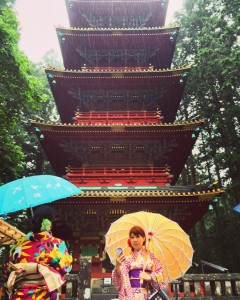
Working in a Japanese lab has been a very new and thought-provoking experience for me. The Orientation program gave me some insight about the structure of Japanese labs, but I have learned the true dynamic of research groups through personal experiences and interactions with my lab mates. Initially, I thought that Japanese labs were more serious and individual-based than labs in the US, but I find that my expectations were not very accurate. The main difference is the dynamic of the lab. I quite enjoy having all of our desks clustered together in one room, so that when my lab mates are not in the clean room, we can easily talk to one another. I find that even though our lab ranges from fourth year undergraduates to PhD students, everyone is really good friends. There is a definite distinction between people’s years and emphasis on pleasing the head research professor (Aoki-sensei), but I now see the natural inclinations for this behavior. Even in my lab back at Cornell, there are standards that need to be followed in order to coincide with the head professor’s expectations and to create a strong working environment. Although PhD and master’s students are placed higher than the undergraduate students in our lab, everyone tends to work each other and help each other achieve a common goal. The less experienced students feel comfortable asking other lab mates for help, so I find our Japanese lab to be more collaborative and social than I expected. I also appreciate that there is consistent contact with the main professor in our lab. In the US, I work closely with a PhD student who is in charge of me and seldom speak or hear from the research professor. I am taught how to perform my tasks and am told that I can ask for help if needed. However, in my Japanese lab, I am guided through the process and feel more comfortable asking any of the students for help, not just the main student that is in charge of me (my mentor). It is not just me that receives plenty of help; the undergraduate student who I work closely with also receives help from many people in the lab—even students with separate projects.
Another primary distinction between my lab in the United States and my Japanese lab is the lab meetings that are held. In my US lab, only the master’s students and the research professor have a brief meeting once a week; I am not told to attend. Since I work under a PhD student, she is in charge of me and gives me instructions on what she wants me to do. However, in Aoki-sensei’s lab, I feel that everyone works together as one unit because we are updated on each other’s projects every week. On Friday afternoons, each lab group presents a PowerPoint on what they have been working on during the week. This is a time to reflect with Aoki-sensei on what worked and what did not work. I am pleased that my data and progress is also included in the slides every week; I feel that my effort in the lab is a key component to the progress of our research, just like everyone else’s. In my US lab, my data collection is also essential to our research study on cardiovascular diseases, but I do not get to present my work—it is only analyzed by the student in charge of me.
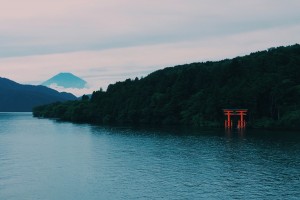
Although I do not feel that there are any rules or expectations in the lab that felt significantly different from those in my lab at Cornell, I do experience more pressure to consistently produce results and understand what I am doing. Friday afternoons are research progress meetings, but Wednesday mornings are research paper presentations. During these lab meetings, a selected student from our lab presents a published paper related to his/her research and thoroughly analyzes it. Throughout the presentations, Aoki-sensei and some of the older students ask questions to make sure that the student presenting genuinely understands the experiment that was conducted and the concepts behind the study. These presentations last anywhere between an hour and 2.5 hours, depending on the student’s understanding. Students typically start preparing two weeks before they know they will be presenting because reading an English research paper and understanding all of the concepts can be very demanding. There seems to be a lot of pressure on my lab mates, but I do see the point of these weekly meetings. Especially in today’s society, where research is booming more than ever before, it is important to stay updated on recent findings. This can improve one’s personal understanding of one’s own research. I have not seen this occur in any of the labs I have worked in, so I am interested to know if this is a common occurrence.
In terms of value, I believe both Japan and the United States care about the broader impact of the research conducted. In both of the labs I worked in, the purpose of our studies were made clear from the beginning. Sometimes these goals change, but all of the students are dedicated to solving a wider problem. However, I do find the work environments to be very different. In US labs, the mentality seems to be about efficiency: work diligently but quickly. However, in my Japanese lab, there tends to be more down time. Because of this, everyone seems to work significantly longer hours. While it sometimes frustrates me that the pace of research progress seems to be going too slowly for my liking, I also enjoy the social dynamic in our lab that originates from this down time. It appears that my lab mates do not mind being in the lab until late evening and sometimes even night. Growing up in a fast-paced environment on the east coast of the US, the slow speed of Japanese research is difficult to get used to, but I am open-minded about the different work ethic and try to embrace it. Even though I prefer the pace of my lab in the US, I can see the positive sides to the Japanese work mentality through this internship.
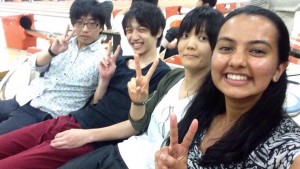
Question of the Week
Is the work dynamic my Japanese lab atypical? I did not expect the collaborative and social environment among my lab mates, who range from fourth-year undergraduates to PhD students. Everyone seems to help each other and socialize even outside of lab, and the head research professor is almost always present in our research facility. I wonder if my experience would be drastically different if I were placed in another Japanese lab.
- Yes, every Japanese lab does have a different culture and personality and these can change from year-to-year too as students graduate and new students come in. Each lab group member helps set the tone/group dynamic just as much if not more than the professor. Overall though, Japanese labs tend to place more emphasis on the group dynamic and US students often find there is more group socializing in a Japanese lab than in a US lab. But if you read the reports of the other 2016 Nakatani RIES US Fellows you’ll see that there are vastly difference experiences depending on the host lab but also (importantly) depending on the individual’s outlook and what they are bringing to the table too in terms of their own engagement with the unique nature of their host lab. Never underestimate the difference that your own curiosity and positive perspective can have when navigating group dynamics.
Research Project Update
This week, I have been focusing on analyzing my data collected from my sample at high temperatures. By using KaleidaGraph, a graphing and data analysis application for researchers, we can determine the activation energy at each temperature during our annealing process, from 360 K to 500 K. We are calculating this by using Id = Idoexp(-Ea/KBT), where Id is the final drain current, Ido is the initial drain current, Ea is the activation energy, KB is the Boltzmann constant, and T is the temperature. Looking at a previous research paper, we are comparing our results to a ln(Id) versus 1/T graph at different voltages, from 0 V to 40 V. Since my graph was successfully linear for high temperatures from 440 K to 500 K, we were able to calculate the activation energy at all temperatures. To plot, we looked at each temperature’s drain current versus gate voltage graph. We zoom in on where the transfer curve experiences a sudden jump in drain current and make sure that the correlation value is close to 1.000. I have been learning how to use KaleidaGraph and how to calculate the activation energy, which we measure in eV’s. We have found that it might be better to compare the activation energy at each temperature with a voltage gate of -40 V rather than at 0 V because the R-value is greater at -40 V. Comparing the lines of best fit at these two voltages, we will most likely get more accurate activation energy values at -40 V.
This week, the Nakatani Program stopped by Chiba University for a lab visit. Professor Kono, Ogawa-San, and Sarah-San got to see what I have been working on for the past month and speak with both Aoki-sensei and Ochiai-sensei. It was nice to have everyone together and talk about my experience in the lab thus far. I described the fabrication process in detail and showed Professor Kono how we use Raman imaging to calculate the number of layers my sample has. Afterwards, Professor Kono gave a lecture on a recent discovery about graphene, which was interesting for my lab in particular because many of my lab mates are studying some of the concepts that were covered. This lecture was given to master’s students, who attend these seminars twice a month. Some of the uses of graphene were covered in Professor Kono’s lecture during Orientation, so it was nice to learn more about this area of study. I also enjoyed the lunch we had afterwards because a Chiba University student interested in applying to the Nakatani Japanese Fellows Program also joined us. Initially, he was hesitant to talk to me because of his lack of fluency in English, but this situation reminded me of how my lab mates acted around me when I first arrived in June. After speaking a mixture of Japanese and English to start a conversation, the Chiba student started to gain more confidence and spoke more. At the end of the lunch, we exchanged contact information and made plans to meet up again to practice speaking and to hang out. Overall, the Nakatani Program’s lab visit was both enjoyable and a time to reflect on my progress.
Week 09: Reflections on Japanese Language Learning
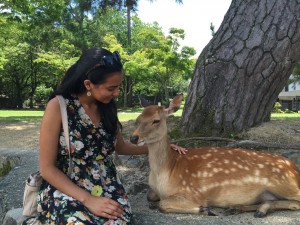
The language classes we took at the beginning of the summer have been invaluable and an integral stepping stone to my immersion in my Japanese lab and sightseeing experience. At the conclusion of our first three weeks in Tokyo, I was unsure of how much I would be able to retain and what vocabulary I would find to be most useful, but it has turned out that I have genuinely used everything I have written down in my notebook from the language classes in the past two months. When I am sightseeing, being able to ask for directions in Japanese and reading signs written in hiragana and katakana has been very helpful. Along the way, I have been able to build up my vocabulary to include cardinal directions and names of certain landmarks. Through my lab, I am often asked what I did over the weekend and my hobbies. Being able to describe my daily life and ask questions about their hobbies has helped me learn more about my lab mates and further build my Japanese vocabulary. Overall, I am happy that I have continued to use my Japanese extensively both in my lab and when I am traveling.
Being able to communicate with others is important in developing social relationships. I cannot count the number of people I have met through my travels, from the couple I talked to on a boat ride in Hakone to my Airbnb host in Chigasaki, who have shaped my experience in Japan. Even knowing the little Japanese that I do, we are able to hold a conversation and make meaningful directions. I have received invaluable advice on places to visit in Japan and on new things I should try because I am willing to try to speak the language. While my Japanese vocabulary has continued to grow, thanks to my lab mates, I continue to struggle with sentence constructions. I hope that during my next three years in college, I will be able to join a Japanese class to further improve my communication skills.
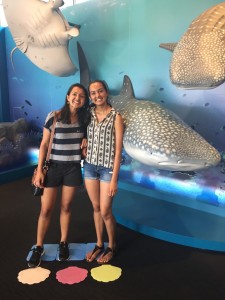
In order to ensure that I am fulfilling my summer goal to learn something new in Japanese every day, I continue to write down new words and phrases in my lab notebook that I often hear my lab mates use. Later in the day, I either ask one of my lab mates to explain what the word means or look online to see how it is used. I find this to be a helpful learning tool for me, rather than studying solely from a textbook, because I retain words that are most often used and am able to use them in the informal sentences that my lab mates use to communicate with one another.
At times, linguistic experiences can be challenging and a hurdle to overcome. This past weekend, my sister and I stayed at a hostel in Kyoto in order to experience the first weekend of the Gion Matsuri festival. The host understood very little English, so at times it was difficult to ask him where certain facilities were and how to rent bikes for the day. Despite the initial confusion about what we were saying to one another, through hand gestures (and using a little bit of extra help from Google translate), we were able to explain our situations. Back in May, I probably would have felt overwhelmed by the amount of Japanese spoken to me that I could not understand, but I am now getting better at picking out words I do know and trying to understand through different means, such as pointing at things or even drawing pictures.
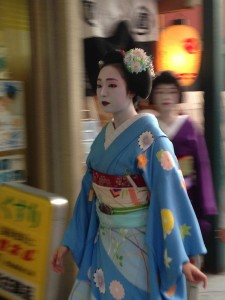
Question of the Week
What is the timeline like for the Gion Matsuri festival? When my sister and I went, we got to view the floats that would be paraded along Karasuma and Shijo streets, but we were told that there would be festivities the following week as well.
- The JapanGuide.com site on Gion Matsuri has a helpful overview with update to date information on the current year. The Kyoto Visitors Guide is also a helpful site to learn more about this festival.
Research Project Update
After having a lab group meeting about some of the topics that Professor Bird recommended studying, there have been multiple projects going on in the lab. Thermally-assisted memories represent an emerging area of nanotechnology, and the capacity to realize this in monolayer form may allow for the development of transistors at smaller sizes with high scalability. Our study is now focusing on how this memory effect is still present when both the gate voltage and source-drain voltage are removed. First, as established in our primal experimental goals, we will study the effects of temperature on memory. We want to see if a high temperature is needed for all stages of the memory cycle. We also want to see if it is possible to observe the current jump on the transfer curve when cooling the memory program from a high temperature (500 K) to room temperature. This study will determine how long it is necessary to hold the sample at elevated temperatures during the memory cycle. Essentially, without applying a voltage gate, we will decrease the temperature to room temperature. The transfer curve that this action creates will be compared with all of the other transfer curves that we will graph by varying the temperature. We will see if the current jump is still observed and how its characteristics compare to those seen in a usual measurement, where the temperature is held fixed at 500 K. MoS2 is n-type, and a current jump indicates when a negative charge is released. Aoki-sensei also clarified for me that the leakage current prevents the current from going to zero. We predict that at high temperatures, the transfer curve will be shifted to the right, compared to the original curve that we will plot. This is because we expect that as an electron is released, the graph comparing drain current versus gate voltage shifts to the right.
Our second study demonstrates non-volatility and will confirm the charging dependence. We will first sweep the gate voltage to -40 V in order to program the memory effect. Next, we will sweep the gate voltage back to 0 V and reduce the source-drain voltage from its initial value back to 0 V. As Professor Bird described, the transistor will be completely “powered down.” After some time, we will resume the gate voltage sweep up from zero towards positive gate voltage and observe if the current jump is still present. If time permits, we will study the influence of varying the hold time in the powered-down state.
Throughout the week, we have also been calculating characteristics such as the sub-threshold swing of my sample. The subthreshold swing describes an exponential behavior of the current as a function of voltage. A small subthreshold swing indicates better channel control (an improved ON/OFF current ratio), leading to less leakage and less energy. We observe temperature dependence of the subthreshold swing from SS=[d(log10IDS)/dVGS]-1. We have been using this paper, which was recently published, extensively.
Park, Y., Baac, H.W., Heo, J., & Yoo, G. “Thermally activated trap charges responsible for hysteresis in multilayer MoS2 field-effect transistors.” Applied Physics Letters 108.8 (2016): 083102.
Week 10: Interview with Japanese Researcher
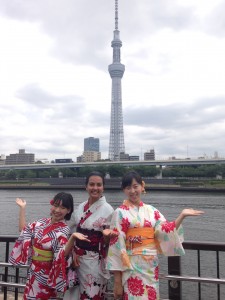
I decided to ask Mineharu-san, a graduate student in my lab, about his career background because he is always interested in what I study at Cornell University and comparing Japanese and American labs. Mineharu-san is a second-year master’s student and is a member of the graphene group in our lab. He is currently in Chiba University’s Graduate School of Advanced Integration Science and is obtaining a degree for his nanoscience interests. This graduate program is comprised of two divisions: the Division of Nanoscience and the Division of Information Science. Mineharu-san told me that the Division of Nanoscience includes both nanomaterial science and nanobiology, the latter in which is closer to my intended major (biomedical engineering).
Mineharu-san chose to study nanoscience because he is interested in developing technology with new materials. He likes learning about what materials consist of, so learning about this on a nano-scale level seemed like a suitable major for him to study. Mine-san also completed his undergraduate studies at Chiba University. He was interested in learning from me that in the United States, many people attend a different university after obtaining their bachelor’s degree if they want to go to graduate school. In Japan, it is very common to stay at the same university for both undergraduate and graduate studies.
At this time, Mineharu-san is ready to work instead of obtaining a PhD, and he is looking forward to the new experiences after he obtains his master’s degree this year. After graduating, he will be working at a company that manufactures devices used around the office, such as printers and copy machines. He will be developing these machines for this company and is eager to use his knowledge on the integrated sciences to help. We both agreed that a degree in the STEM fields offer flexibility with where you can work in the future; he likes that nanoscientists can work in either research or industry.

Throughout my time in Aoki-sensei’s lab, I am often asked by Mineharu-san about the differences of the working environment in Japan versus the United States. He believes that researchers in the US are more independent with their experiments, whereas the environment in Japanese labs are more collaborative. I agree with his conception to a certain extent. In the US labs I have worked in, the tasks are usually divided up so that I can work on things on my own. Although I often work with some other lab mates when we are experiencing difficulties or problems, I do not know them on a personal level. However, in my Japanese lab, we work on each task as a group; I make my samples on my own, but I join the fourth-year undergraduate and first-year master’s student to conduct our experiments. Also, Mineharu-san said that since there is a lot of down-time in the lab, everyone gets to know each other well and make good friends.
In the future, Mineharu-san is interested in working abroad. He has taken the TOEIC test and IELTS test in order to improve his English and be able to work in companies abroad if given the opportunity. Right now he would like to start working at the Japanese company that accepted him as a new employee, but he would like to travel to another country for research or work in the future. Mineharu-san is fascinated by how common changing jobs is in the US. He explained to me that in Japan, people work at the same place for up to fifty years in order to obtain higher positions and be a respectable worker in the job force. He is intrigued that Americans tend to change their jobs very often if the opportunity arises, especially for those who have just completed college. We have had some long discussions about comfort versus change and have come to the conclusion that it is difficult—but possible—to embrace both in one’s lifetime.
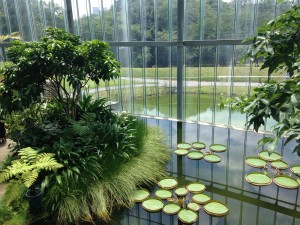
Question of the Week
This week, some of my lab mates took the TOEIC exam. What does this exam consist of, and do students typically take it more than once? I heard that it is offered every month.
- The TOEIC, TOEFL, and IELTS are all commonly used tests of English as a foreign language that are taken by international students who want to study or work in an English-speaking country or university. Which test you take varies by the requirements of your host country or host university and most universities require a minimum test score for admission as either a degree-seeking student or as a study abroad student. This means that the English test is often a barrier to entry for study abroad faced by many Japanese students and why their reading and writing skills in English may be stronger than their conversational skills since they’ve probably spent more time studying for the test than actually speaking in English. In comparison, it is quite easy for U.S. undergraduates to study abroad as there are often many programs to choose from that require no prior language study and no minimum test score to apply. For more on resources/advice for international students who want to come to the U.S. see some of the websites below.
Research Project Update
This week, I went back to helping my group make a monolayer MoS2 sample, which would be easier for us to conduct the experiments that we established last week. We have continued to struggle with the fabrication process, so we had a discussion with Aoki-sensei to determine how we should proceed. Aoki-sensei recommended that we use one of Professor Bird’s samples to conduct our experiments so that I can maximize my time in the lab for these last two weeks. Some of the PhD students helped us determine where we should place the electrodes. At this point in our project, it seems like more and more students are helping me, my mentor, and the undergraduate student in our group because we have been facing more obstacles than expected. My mentor has also been focusing on how MoS2 displays similar characteristics to metals, so I will be analyzing his data with him.
Earlier this week, using Kaleidagraph, we also found the activation energy and interface trap density (Nt) for both monolayer and multilayer MoS2. The multilayer form had higher values for these two characteristics. We found these values by relating the maximum charge density (Qm) and temperature-independent charge density (Qfix) together. We graphed the change in Qhy (C/cm2) versus the inverse of temperature (1/K) and will now study Qfix more in depth. The trap densities responsible for the hysteresis are determined by the amount of charges (ΔQhy) captured and released, which is given by ΔQhy = COX × ΔV, where COX is the oxide capacitance and ΔV is the change in hysteresis. I am hoping that this coming week we will get started on using Professor Bird’s sample so that I can learn how to conduct some of the experiments that we want to perform and to collect some data.
Week 11: Critical Incident Analysis – In the Lab
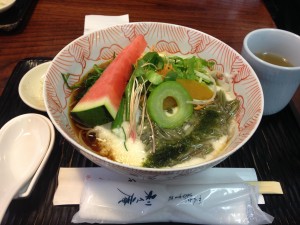
There have been a series of cross-cultural communication that have occurred pretty much every day that I have attended my Japanese lab, which highlights what makes this international research experience different from if I were conducting research back in the United States. Over these past two months in lab, there have been communicational misunderstandings, difficulties, and barriers, but I have genuinely had so much fun along the way trying to overcome these hurtles and getting myself to understand that it is okay that my Japanese is still limited.
I think the main takeaway from my time in the lab is that people are willing to communicate with you if you show interest in communicating with them. As arbitrary as this may sound, it is actually really easy to not communicate much with others in a work environment and to fall into a habit of working on tasks independently. However, by doing this, you miss out on so much knowledge and socialization. Even though I cannot communicate very easily with my Japanese-speaking lab mates, I can genuinely say that I am closer friends with them than with lab members I have worked with in the past in the US. The more I try talking to them in Japanese to show that I am curious about research, their culture, and learning about them, the more naturally they communicate with me in English or other means (hand gestures, Google translate, etc.).
I have noticed that in casual Japanese conversations, the pronoun of the sentence is left out; I seldom here “I” or “you” because the pronoun of the sentence is often implied. One day in the clean room, one of my lab mates and I were taking turns making new samples and using the microscope to search for monolayer MoS2 for hours. Around evening, we took a break and I commented something about him working very hard in the lab and how he looked tired. I left out the pronoun in the sentence in order to sound more authentic while speaking Japanese, but I ended up causing a misunderstanding. My lab mate thought that I was referring to myself and saying that I was tired, which in the given situation made it seem as if I was frustrated with doing the same task all day and wanted to stop. He politely told me I could leave early and relax even though I was not tired; I enjoyed contributing and being productive. I went on to clarify what I meant and he did not seem to believe me, but after a few days of me showing up early to lab and asking curious questions like I usually do, he resumed to act normally around me and to not be concerned about over-working me/tiring me out. Thankfully this encounter did not cause any lasting implications in the end, but it was a misunderstanding that was caused by my lack of understanding in when I could leave out the pronoun of a sentence when speaking in Japanese.
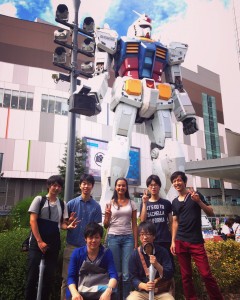
There have also been times when my inability to understand what my lab mates are discussing has led to confusion about what I should be doing. Sometimes I do not realize that my group is talking about what they would like to work on in the clean room or why we are changing certain aspects of our experiment. More than once, I will be at my desk on my laptop and not realize that my lab group went to the clean room. I think they do not like telling me what I can and cannot do, so they must have not wanted to disturb me in case I was working on something important. For me it can be frustrating because I want to know what is going on and do not want to miss out on anything that is happening with our project, but this occurrence is simply because of the language barrier. I have learned to overcome this by being more aware of when my lab mates are talking as a group and tagging along even when they go to the clean room individually. At first I was self-conscious about this because I was afraid that I would be bothering them or interfering, but they don’t seem to mind at all and proceed to explain what we are doing when I ask. They have become much better at making more eye contact with me and through body language in when I should come, so I definitely feel more a part of our lab group.
Of course, casual, social conversations are still challenging due to our limited abilities to speak in each other’s languages, but we have continued to improve and still have fun. Through the help of everyone’s English knowledge, Google translate, excursions, and card games, I have learned a lot about my lab mates. It is often difficult to express myself fully because I always try to speak in Japanese with a few basic English phrases, but I think they have a better understanding of my personality as well. My lack of being able to speak Japanese well has not presented itself to be a large social or academic barrier. I am not able to share my thoughts as openly as I can in English, but I do not find this to be a negative obstacle; it has increased my awareness of cross-cultural communication.
Question of the Week
Japan’s recycling and waste disposal system is extensive and followed by the general public, but I was wondering how it compares to the United States’ disposal system. Although I feel like Japan does a better job at separating the types of recyclables, it seems that they use more plastic than the US. For example, more items seem to be individually wrapped and water bottles use a much thicker layer of plastic than what I am used to purchasing. Are there any statistics on how these two countries compare?
- Differences in waste disposal and garbage/recycling are also often things that the Japanese students who are in the U.S. ask about too. They are shocked that, even though we have less individually wrapped items, the U.S. has such a poor rate of recycling and so few options of what can be recycled. If you Google “Waste and Recycling in Japan vs. the U.S.” you’ll find many articles and websites that outline some of the differences between the nations.
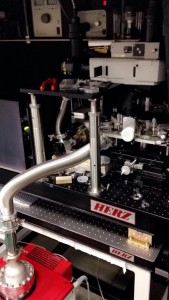
Research Project Update
After testing on some of my samples throughout the summer, we have proceeded with using both my mentor’s MoS2 sample, where I found a 5-micrometer monolayer fragment. We are also using one of Professor Bird’s monolayer CVD samples to collect data. My lab group wrote out a plan for how we annealed our sample and proceeding with data collection. We first obtained Id-Vg measurements at room temperature for thirty minutes. The annealing process, which lasted about eighteen hours, started off at a temperature of 393 K. Again, we measured Id-Vg in the vacuum at room temperature. Nest, we annealed our sample at a high temperature (500 K). Since the Id-Vg graph of the transfer curves showed a jump, we were able to proceed with our experiments. First, we want to see how time may shift the transfer curve in between gate voltages, at a fixed temperature of 500 K. We adjusted the program that we were using so that the gate voltage sweeps in the following pattern: 0 Và 40 Và -40 Và 0 V. The first time around, we do not wait; we allow 0 minutes and proceed to the next gate sweep. The second time around, we waited one minute. The third time around, we paused for two minutes, etc. We stopped this pattern once we saw a significant difference between our 0-minute transfer curve and our time-dependent transfer curve, at nine hours. We saw that there was not as large of a jump at long times, revealing that time is also affecting our results.
Our next experiment involves seeing the effects of temperature on our Id-Vg measurements. We measured the transfer curve at 500 K after finishing up the annealing process. We then plan on dropping the temperature from 500 K to 300 K. We hypothesize that the charge will be stored as we drop the temperature, so the transfer curve graph will be shifted more to the right compared to the graph at 500 K. However, the time it takes to reduce the temperature to 300 K must also be considered; there may be a difference between dropping the temperature immediately or setting the time scale so that the process takes, for example, 24 hours to complete. These are findings that are important to know when making memory devices. The difference between our first and second experiment is the gate voltage. In the first part, we are varying the gate voltage (from -40 V to 40 V) and the time. Our second experiment involves comparing time and the drain current. Our findings show a clear pattern, and I am looking forward to collecting more data for this second part of our experiment.
Week 12: Final Week at Research Lab
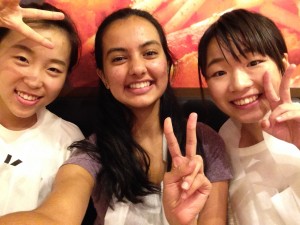
My experience in Japan has truly been eye-opening and life-changing. The past three months have been challenging, but rewarding nonetheless. I have learned a lot about myself through traveling on my own, meeting new people, working in a Japanese lab, and trying to overcome the language barrier. I have noticed that throughout my time here, I could not help but compare Japan and the US because each country’s people differ quite drastically in culture and lifestyle. It took a long time to adjust to some Japanese norms, such as the quietness on trains and the overall slower pace of things, but I have come to appreciate them more. When I go back to the US, I hope that I can achieve a harmony between the fast-paced, independent-driven life that I am used to and the calm, group-oriented dynamic that Japan offered me.
Sightseeing will always be something that I enjoy doing, but I will miss the people that I shared these experiences the most. Although I faced the most language barriers with my labmates, I am definitely going to miss them the most. Admittedly, there have been many frustrating and difficult times in the lab where I felt lost and almost lonely because I was not able to join group conversations in lab. Sometimes I would have to comfort myself and remind myself that it is okay that I was feeling this way—being in lab for a minimum of eight hours a day with little English can be draining. However, the multiple times when I have had one-on-one conversations with my labmates, played games, went sightseeing with them, and laughing over the most random things made me genuinely want to go to lab every day. I have gotten to know everyone well, and they have been nothing but welcoming and genuine with me. I thought I would always be viewed as a guest in the lab, but I now feel that they welcomed me into their group from the start and treated me as their equal. This is something I have never experienced in its entirety before and am going to miss the most. When someone asks me what my favorite part of Japan was, I am going to say my lab. They never failed to make me smile. During my final two weeks in lab, when I was spending even more time with them due to the work we had to put into our ongoing experiments, I enjoyed my company with my labmates more than ever before. The more serious the work, the more we collaborated and laughed—a very odd combination but humbling experience for me.
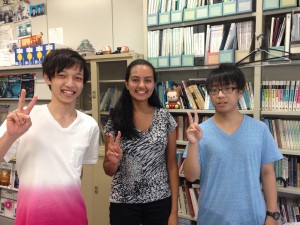
The research I conducted this summer was in a subject area that I was very unfamiliar with, but I wanted to learn more about nanoscience and challenge myself academically. I have a much better understanding of the research I helped to conduct after reading multiple papers, discussing with Aoki-sensei, asking my labmates questions, and emailing Professor Bird for points of clarification. I see the overlap there can be between biomedical engineering and nanoscience, so I am looking forward to going back to Cornell University to see how I can integrate my new knowledge into my academic coursework. Even if the experiments I conduct are of a different nature, I will no doubt be seeing topics such as semiconductors and memory in my future engineering classes.
I hope to keep in contact with some of my labmates, Nakatani friends, KIP students, and the other people I met at Chiba University. I feel lucky this summer because not only did I make new friends in Japan, but I was also able to spend time with two Cornell friends, my sister, and my cousin. I enjoyed traveling with each of them, and I never felt alone despite being the only student placed in Chiba. My final week consisted of enjoying Chiba with two of my Chiba University friends that I met on my commute, eating dinner with two of my labmates after a late night finishing up research, and having a lunch party for my departure.
Climbing Mount Fuji is also an experience that I will never forget. I enjoyed climbing with Ben and Nickolas, and we toughened it out at the summit when the temperature dropped. I am glad we started climbing early so that we had a good view
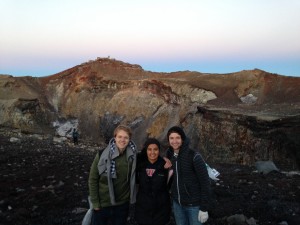
of the sunrise, and it was much easier to climb without many hikers in the way. However, because we reached the summit early, we had to wait in the cold for a long time. I have heard that it usually rains near the summit, but we were fortunate with clear skies. Climbing Mount Fuji is definitely an experience I will never forget—it was both the most difficult physically, yet the most rewarding. Climbing Fuji was something I really wanted to do when I found out I was coming to Japan this summer, and I am proud to be able to check that off of my bucket list. In fact, all of the things that I set out this summer to accomplish prior to the Pre-Departure meeting were satisfied; my goals helped me direct the way I wanted my summer to go.
Question of the Week
I am looking forward to getting to know the Japanese Nakatani students this week. Will they be writing weekly reports as well? I would like to hear about their experience in the US and the types of research they will be helping to conduct.
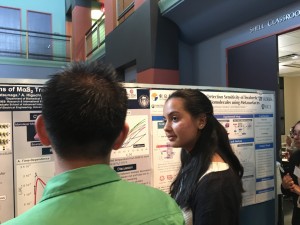
Final Research Project Update
Research Project Abstract and Poster: Applications of MoS2 Transistors to Nonvolatile Memory ![]()
Host Lab in Japan: Aoki Lab, Chiba University
Under Aoki-sensei, at Chiba University, my final research project was on the “Applications of MoS2 Transistors to Nonvolatile Memory.” I was apart of the Scanning Probe Microscopy group, which also included my mentor Yamanaka-san. Thermally-assisted memories represent a growing area in nanotechnology, where heat is used to ease the switching action between memory states. My group has been studying MoS2, particularly in monolayer form, because of its wide bandgap of 1.8 eV. Previous studies that my lab has conducted with monolayer MoS2 show that when the gate voltage is swept at high temperatures, there is a jump in drain current at Vg= 0V. This jump is caused by SiO2 because of the negative charge. Since MoS2 displays n-type characteristics, it cannot contain positive charge. Therefore, at Vg= 0V, negative charge flows out due to the imbalance of charge. Now, my lab is studying both temperature-dependence and time-dependence. For temperature-dependence, my lab saw in the past that the current jump only took place at high temperatures. When I was in lab, we varied the temperature and saw when the current jump occurred, and we also compared this characteristic between a monolayer sample and my fabricated multilayer sample (4-5 layers). We saw that monolayer MoS2 exhibited larger current jumps than multilayer, most likely because there is much less screening in the monolayer case. Aoki-sensei and Professor Bird explained to me that this would mean MoS2 is more sensitive to changes in stored charge in the oxide layer. We do not know if this is necessarily true though. Our time-dependence study took into consideration how the time pause between sweeps affects the Id-Vg transfer curve as well. We approached this study with two differently-designed experiments based on trial-and-error. First, we swept the gate voltage from 0V to 40V to -40V to 0V and then waited for a set number of minutes before sweeping the gate voltage again in the same pattern, while graphing the gate voltage. Since this was very time-consuming for us to restart the program every time, we next designed a custom program that only swept the gate voltage from 0V to 40V to -40V to 0V once in the beginning, and varied the time for the drain current to be recorded at Vg= 0V. Both experiments turned out to give similar results, with only some error points. We saw that as time increased, there was less of a jump in drain current. However, we found an interesting behavior with our two very long times, where 540 minutes experienced more of a jump than at 360 minutes. This is an interesting finding that my lab aims to investigate more in the future.
Throughout my time, I have learned about scanning probe microscopy, the exfoliation process, photolithography, and Raman imaging. I was able to use many of the equipment on my own freely because my sample was often times the “test” sample that we would use to make sure that our actual data collection with my mentor’s sample wold run smoothly. My approach to our research was learning as much as I could about the material from Aoki-sensei and related papers so that I had a general understanding. In the clean room, I wrote down details of how to perform each task, especially on how to exfoliate a sample using the scotch-tape method. As for data collection, I learned about KaleidaGraph and mainly analyzed the results with the rest of my research group. Our Friday lab meetings mainly consisted of discussing what our results showed with Aoki-sensei, which proved to be beneficial for my understanding.
Future studies include creating a top gate structure with monolayer MoS2. The sample we fabricated was a back gate, with SiO2 placed on top of Si. My lab also wants to study the n-type characteristics of Cr/Au contacts to MoS2 by using scanning gate microscopy. I plan on keeping in contact with several of my labmates and hope to find out more about what they are working on in the next few months.
Week 13: Final Report
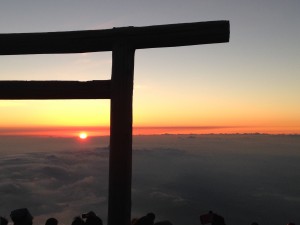
The Re-Entry Program was a great way to spend time with the US Fellows as well as get to know the Japanese Fellows. My last night in Houston consisted of hanging out with the US Fellows at our hotel, which made me realize how much I was going to miss them. It is amazing that we are from all different parts of the country and did not know one another prior to this summer. I know that we will continue to stay in contact, and it is possible for some of us to meet up in the future. The Japanese Fellows were very easy to talk to—I wish we had more time to socialize with them, but the Re-Entry Program mainly consisted of lectures and poster presentation preparations. I enjoyed visiting NASA as a group, though, and socializing with everyone at Professor Kono’s house.
After speaking to family members, the most important thing I learned from Nakatani RIES was building confidence in my independent travels and living. Prior to this summer, I had no experience with living on my own for an extended period of time and having to get to places with little assistance. I was hesitant at first to venture out, but I enjoyed it more and more as the summer progressed. If I ever study abroad in the future or live on my own, I feel more prepared for what to expect. I am glad I got to experience this as a freshman because this will help me as I progress through college.
When speaking to a professor, I think they would be most impressed by my ability to work with fourth-year undergraduates and master’s students on a project outside of my major. This allows me to be more interdisciplinary rather than only having exposure to biomedical engineering research. The skills I learned, such as the exfoliation process and Raman Imaging, are skills that I can apply to other research labs as well. My basic understanding of the applications of scanning probe microscopy is something I can talk about with other professors at Cornell.
An employer would be most interested in Nakatani students’ ability to communicate well with international engineers. More than ever before, graduate programs in the US consist of a high percentage of international students, so being able to work well with people who come from a variety of backgrounds is important. Employers are looking for employees who can collaborate with a diverse team to make a global impact. It is essential in today’s society to be able to think about the wider impact of one country’s actions on a global level. Having experience with working in a Japanese lab gives me the advantage of learning another language, which means that I can communicate effectively with more people.
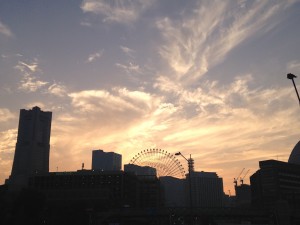
As I share my experience living in Japan with some of my university friends, I would emphasize the global, social network that study abroad provides. The more students travel, the more people they meet. Nakatani RIES is unique in the sense that all fourteen of us were spread out across Japan, so we were not travelling as a group most of the time. This enabled me to more easily interact with local Japanese people rather than stick to just my American friends. Through Nakatani RIES, I was also able to shape the way I wanted my summer to go because I had the opportunity to plan my own weekends. Students typically want less structured programs and more free time, so having two months at our host labs enabled me to see whatever I desired.
After my participation in Nakatani RIES, I am more interested than ever before in participating in another REU either over the summer or during my winter break. Study abroad is also an option, but I liked gaining hands-on exposure in a research setting rather than taking formal classes at an English-speaking institution abroad. I would also like to continue my Japanese language studies either on my own or at Cornell. I have also been in contact with some of my labmates and am hoping that they can help me continue to improve my Japanese. There are a few clubs on my campus that promote Japanese culture, such as the Japan US Association. They hold events for people to learn more about Japanese culture and have meetings throughout the month, so I think it would be great to join the association now that I know more about Japanese culture.
Final Question About Japan
Is working in industry more popular in Japan than pursuing a doctoral study? How do these statistics compare with the US? At American universities, there are so many international students who are aiming to get a postdoctoral degree, but it seems that more students in Japan are going into industry rather than continuing research after their master’s.
- Yes, you are correct. Most students in science and engineering in Japan who go on to get a graduate degree only get a master’s degree and then they seek positions in industry. This is partially because universities in Japan do not provide any funding (tuition remission or stipend) for master’s or Ph.D. funding so students must almost wholly self-fund their graduate studies. In the U.S. it is much more common for students to apply directly to a Ph.D. program in science or engineering that offers full funding and they complete a master’s on their way to Ph.D. Yet, due to the limited numbers of academic positions in various fields, U.S. students should also investigate alternate career paths in science and engineering as well. For more, see our resources pages on Research in Japan and Research in the U.S.
Tips for Future Participants
Chiba is a really convenient place to live, and I found everything to be much cheaper than in Tokyo. Although my dorm room was small, I felt lucky to have my own kitchen area and bathroom. I suggest waiting to buy items that you will need in your dorm room once you arrive because I had plenty of time to search through the nearby stores to find cheap items that would make my stay more comfortable. Also, Chiba was much bigger than I expected it to be. I would recommend exploring the area during days that you get out of lab early or one weekend. I learned a lot about Chiba’s history from a museum that was located inside Inohana Castle and enjoyed walking around one of my favorite places: Makuharikaihin Prefectural Park. There is also a Costco in Chiba that Haihao visited when he was in Chiba, so I think that would be cool to compare to US Costco’s! Chiba has some beautiful beaches that I wish I made the time to visit, too.
I also recommend getting a student discount on the train between your dorm and campus as soon as you get your student ID number because that saved me a lot of money and was really cheap. Another option is to rent a bike because Chiba University is pretty close to the international dorm that I was staying at.
Language Study Tips: If you are conducting research at Chiba University, Aoki-sensei will encourage you to sign up for a Japanese language class, which was a great way for me to improve my language-speaking abilities after the three-week classes that all the Nakatani students take at the beginning of the program. I also built my vocabulary by simply listening to my labmates and asking them questions about the common phrases I heard. I would write everything down in my lab notebook so that I could refer back to them throughout the day. I recommend studying Japanese from the AJALT books during your free time, which I wish I had continued to do.
What Gifts to Bring: Bring American gifts for your labmates for both your arrival to your host lab and your departure. I had omiyage to share with my lab upon my arrival, but my departing gifts would have been more personal and meaningful had I thought of bringing other miscellaneous things from the US. I ended up giving my lab sweets that I bought in Chiba because I ran out of time.
What to Eat: If you visit Osaka, you should go to Mizuno on Dotonbori for some okonomiyaki. They made me and my sister a vegetarian version, and it was by far my favorite meal I had in Japan.
What to Buy in Japan: Buy exotic Pocky flavors, reusable chopsticks, and little souvenirs from different places you visit around Japan. These served as great gifts to give to my hometown and college friends when I got back to the US.
What to Do in Japan: Stay at an internet café, hostel, hotel, or Airbnb one night. I had fun meeting new people and experiencing different styles of living spaces throughout my travels.
Places to Visit in Japan: Pontocho Alley in Kyoto is a great place to go to at night, especially during the Gion Matsuri festival. I had fun roaming the streets nearby.
